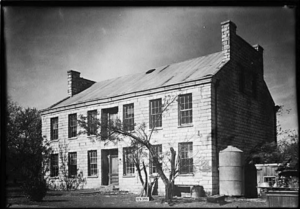No end in sight for decadelong Sneed House debacle
Friday, August 12, 2022 by
Kali Bramble The perennial saga over a cluster of ruins in the Dove Springs neighborhood of Southeast Austin continues, as the all-too-familiar Sneed House case resurfaced at the Historic Landmark Commission last Wednesday.
The remains of the Civil War-era estate have been on the city’s radar since 2007, when property owners introduced plans to develop the surrounding area into an apartment complex. Since then, the project has remained in gridlock, with preservationists’ demands largely unfulfilled as the limestone ruins fall deeper into disrepair.
“This is just long-term demolition by neglect. I mean, let’s just call it what it is.” Commissioner Carl Larosche said.
The Sneed House, one of few remaining pre-abolition structures in Austin, was once a three-story plantation house that served as both a recruiting outpost and makeshift hospital for Confederate soldiers during the Civil War. Arkansas transplant Sebron G. Sneed purchased the surrounding 470 acres in 1852 and spent the next five years overseeing the construction of his estate, using the labor of 21 slaves who quarried limestone from the vast property.

Photo courtesy of Library of Congress. The Sneed House, circa 1936.
The house was zoned historic in 1979, but was partially destroyed in a fire just 10 years later. For a while, the lot was essentially forgotten by those outside academic and preservationist circles. That changed in 2007 when the first murmurs of a residential project brought developers to the Historic Landmark Commission, which agreed to recommend up-zoning with the stipulations of proper stabilization and a 40-foot setback from future construction. By the time the permit trickled down to City Council in 2008, these recommendations were largely lost, with the setback decreased to only 25 feet and the requirement for the landmark commission’s approval of a site plan overruled.
Since then, the Historic Landmark Commission has found its pleas largely ignored, with juggling owners repeatedly abandoning promises of professional maintenance and archaeological assessment. In 2017, Historic Preservation staff began discussing the potential for demolition by neglect, even referring the case to the city attorneys to explore legal recourse. Five years later, the case seems to appear on the commission’s agenda only to be repeatedly postponed.
This time around, property owner Saeed Minhas with the Circle at the Nelms LLC is proposing a three-building, three-story apartment complex that will encircle the fenced-off ruins at a minimum 25-foot distance. Though it will be obscured by the central building, Minhas says the landmark will be accessible to the public via the lobby. According to the provided plan, the perimeter of the ruins will abut numerous amenities, including walkways, a laundry room and a swimming pool.
“We will have a maintenance crew to keep it clean and nice, and to maintain it forever,” Minhas said. “There will be a path outside so that people can go and look at it.”
Still, the Historic Preservation Office is unimpressed. Staffers are concerned that proximity to residential traffic could do damage to sensitive historic remains, especially if maintenance procedures are neglected, and aren’t happy that the landmark will be isolated from the public.
“This is going to be permanently walled off or fenced off … so I guess it doesn’t really serve a purpose,” Commissioner Ben Heimsath said. “What’s to prevent this from just being a place that gets overgrown, filled with trash and neglected?”
Commissioners voted unanimously to postpone the case to next month’s meeting, with their demands including a professional engineering program for stabilization, an archaeological assessment with a long-term plan for monitoring, and a field study on effects to historic resources if the case is to move forward. But after over a decade, no one is feeling too optimistic.
“It looks like we’re going to have a landmark of what happens when City Council doesn’t take our advice,” Heimsath observed.
The Austin Monitor’s work is made possible by donations from the community. Though our reporting covers donors from time to time, we are careful to keep business and editorial efforts separate while maintaining transparency. A complete list of donors is available here, and our code of ethics is explained here.
You're a community leader
And we’re honored you look to us for serious, in-depth news. You know a strong community needs local and dedicated watchdog reporting. We’re here for you and that won’t change. Now will you take the powerful next step and support our nonprofit news organization?









